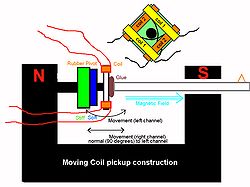
Magnetic cartridge
Encyclopedia

Transducer
A transducer is a device that converts one type of energy to another. Energy types include electrical, mechanical, electromagnetic , chemical, acoustic or thermal energy. While the term transducer commonly implies the use of a sensor/detector, any device which converts energy can be considered a...
used for the playback of gramophone record
Gramophone record
A gramophone record, commonly known as a phonograph record , vinyl record , or colloquially, a record, is an analog sound storage medium consisting of a flat disc with an inscribed, modulated spiral groove...
s on a turntable or phonograph
Phonograph
The phonograph record player, or gramophone is a device introduced in 1877 that has had continued common use for reproducing sound recordings, although when first developed, the phonograph was used to both record and reproduce sounds...
. It converts mechanical vibrational energy from a stylus riding in a spiral record groove into an electrical signal that is subsequently amplified and then converted back to sound by a loudspeaker
Loudspeaker
A loudspeaker is an electroacoustic transducer that produces sound in response to an electrical audio signal input. Non-electrical loudspeakers were developed as accessories to telephone systems, but electronic amplification by vacuum tube made loudspeakers more generally useful...
system.
History
The first widely used type of electric phonograph pickup was commercially introduced in 1925. It was magnetic, but its resemblance to later magnetic cartridges is remote: it employed a bulky horseshoe magnet and the same imprecisely mass-produced single-use steel needles used by non-electronic record players since the 1890s. It had a tracking weight measured in ounces, not grams. By the late 1930s this design had been superseded by a comparatively lightweight piezoelectricPiezoelectricity
Piezoelectricity is the charge which accumulates in certain solid materials in response to applied mechanical stress. The word piezoelectricity means electricity resulting from pressure...
"crystal" or ceramic type, but the use of short-lived metal needles was standard until after World War II, when precision-ground and conveniently long-lasting styli made of osmium
Osmium
Osmium is a chemical element with the symbol Os and atomic number 76. Osmium is a hard, brittle, blue-gray or blue-blacktransition metal in the platinum family, and is the densest natural element. Osmium is twice as dense as lead. The density of osmium is , slightly greater than that of iridium,...
or sapphire began to come into wide use. After the introduction of the vinyl LP
LP record
The LP, or long-playing microgroove record, is a format for phonograph records, an analog sound storage medium. Introduced by Columbia Records in 1948, it was soon adopted as a new standard by the entire record industry...
"album" in 1948 and the vinyl 45 rpm "single
Single (music)
In music, a single or record single is a type of release, typically a recording of fewer tracks than an LP or a CD. This can be released for sale to the public in a variety of different formats. In most cases, the single is a song that is released separately from an album, but it can still appear...
" in 1949, the use of sapphire or diamond styli for these new "microgroove" formats was practically universal. Initially, the styli were simply used in smaller, lighter piezoelectric cartridges of the general type used in inexpensive self-contained portable record players throughout the vinyl era and in most of the "retro" units now being made, but a new generation of lightweight and highly compliant magnetic cartridges came into use among audiophiles in the 1950s and their refined descendants are the most common type of pickup in use today.
Types
In high-fidelity systems, crystal and ceramic pickups have been replaced by the magnetic cartridge, using either a moving magnet or a moving coil.Compared to the crystal and ceramic pickups, the magnetic cartridge usually gives improved playback fidelity and reduced record wear by tracking the groove with lighter pressure. Magnetic cartridges use lower tracking forces and thus reduce the potential for groove damage. They also have a lower output voltage than a crystal or ceramic pickup, in the range of only a few millivolts, thus requiring greater amplification.
Moving Magnet (MM) and Moving Iron (MI) cartridges
In a moving magnet cartridge, the stylus cantilever carries a tiny permanent magnetMagnet
A magnet is a material or object that produces a magnetic field. This magnetic field is invisible but is responsible for the most notable property of a magnet: a force that pulls on other ferromagnetic materials, such as iron, and attracts or repels other magnets.A permanent magnet is an object...
, which is positioned between two sets of fixed coils (in a stereophonic cartridge), forming a tiny electromagnetic generator. As the magnet vibrates in response to the stylus following the record groove, it induces
Electromagnetic induction
Electromagnetic induction is the production of an electric current across a conductor moving through a magnetic field. It underlies the operation of generators, transformers, induction motors, electric motors, synchronous motors, and solenoids....
a tiny current in the coils.
Because the magnet is small and has little mass, and is not coupled mechanically to the generator (as in a ceramic cartridge), a properly adjusted stylus follows the groove more faithfully while requiring less tracking force (the downward pressure on the stylus).
Moving iron and induced magnet types (ADC being a well known example) have a moving piece of iron or other ferrous alloy is coupled to the cantilever (instead of a magnet), while a permanent, bigger magnet is over the coils, providing the necessary magnetic flux.
Moving Coil (MC) cartridges

Since the amount of windings that can be supported in such armature is small, the output voltage level is corresponsingly small. The resulting signal is only a few hundred microvolts, and thus more easily swamped by noise, induced hum, etc. Thus it is more challenging to design a preamplifier
Preamplifier
A preamplifier is an electronic amplifier that prepares a small electrical signal for further amplification or processing. A preamplifier is often placed close to the sensor to reduce the effects of noise and interference. It is used to boost the signal strength to drive the cable to the main...
with the extremely low noise inputs needed for moving-coil cartridge, therefore a "step up transformer" is sometimes used instead.
However, there are available many "high output" moving coil cartridges that have output levels similar to MM cartridges.
Moving coil cartridges are extremely small precision instruments and are therefore generally expensive, but are frequently preferred by audiophiles due to a subjectively better performance.
Moving Micro Cross (MMC) cartridges
The MMC design was invented and patented by Bang & OlufsenBang & Olufsen
Bang & Olufsen is a Danish company that designs and manufactures audio products, television sets and telephones. It was founded in 1925 by Peter Bang and Svend Olufsen, whose first significant product was a radio that worked with alternating current, when most radios were run from batteries...
. The MMC cartridge is variation of the Moving Iron (MI) design. Magnets and coils are stationary while a micro cross moves with the stylus, thereby varying the distances between the arms of the cross and the magnets. It is claimed that the MMC design allows for superior channel separation, since each channel's movements appear on a separate axis.
Moving Magnet vs. Moving Coil debate
Moving magnet cartridges are more commonly found at the 'lower-end' of the market, while the 'higher-end' tends to be dominated by moving coil designs. The debate as to whether MM or MC designs can ultimately produce the better sound is often heated and subjective. The distinction between the two is often blurred by cost and design considerations - i.e. can an MC cartridge requiring another step-up amplification outperform well made MM cartridges that need simpler front-end stages? Every now and then a design comes along to re-open this debate.- MC cartridges offer very low inductance and impedance, which means that the effects of capacitance (in the cable that goes from the cartridge to the preamp) are negligible, unlike MM cartridges, which comparatively sport very high inductance and impedance. In the latter, cable capacitance can negatively affect the flatness of frequency response and linearlity of phase response. This would account for a sonic advantage to MC types.
- It is generally believed that MC cartridges sport lower moving masses. However quality MM cartridges are able to sport lower moving masses than the best MC cartridges. For example, the state-of-the-art Technics EPC-100CMK4 with 0.055mg of effective tip mass, of moving magnet design. Comparatively, the popular Denon DL-301 moving coil cartridge has an effective tip mass of 0.270mg.
- To discriminate cartridges by engine (MC vs MM) overlooks the fact that the stylus tip shape and cantilever have a significant influence in the sound, and this may account for even more sonic differences than the engine type used.
"London Decca" Cartridges
The Decca phono cartridges were a unique design, with fixed magnets and coils. The stylus shaft was composed of the diamond tip, a short piece of soft iron, and an L-shaped cantileverCantilever
A cantilever is a beam anchored at only one end. The beam carries the load to the support where it is resisted by moment and shear stress. Cantilever construction allows for overhanging structures without external bracing. Cantilevers can also be constructed with trusses or slabs.This is in...
made of non-magnetic steel. Since the iron was placed very close to the tip (within 1 mm), the motions of the tip could be tracked very accurately. Decca engineers called this "positive scanning". Vertical and lateral compliance was controlled by the shape and thickness of the cantilever. Decca cartridges had a reputation for being very musical; however early versions required more tracking force than competitive designs - making record wear a concern.
External links
- Cartridge history from a 1958 book

